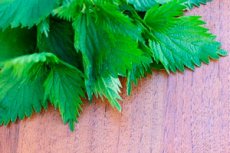Medical expert of the article
New publications
Natural ingredients to strengthen hair
Last reviewed: 04.07.2025

All iLive content is medically reviewed or fact checked to ensure as much factual accuracy as possible.
We have strict sourcing guidelines and only link to reputable media sites, academic research institutions and, whenever possible, medically peer reviewed studies. Note that the numbers in parentheses ([1], [2], etc.) are clickable links to these studies.
If you feel that any of our content is inaccurate, out-of-date, or otherwise questionable, please select it and press Ctrl + Enter.

The ability to inhibit 5-alpha-reductase has been found in many natural substances. An unexpected finding was the antiandrogenic effect of some polyunsaturated fatty acids, especially gamma-linolenic acid. The connection between polyunsaturated fatty acids and androgen metabolism was first demonstrated in 1992. Later, in 1994, gamma-linolenic acid and some other fatty acids were shown to be effective inhibitors of 5-alpha-reductase.
The highest inhibitory activity was observed in Gamma-linolenic acid, followed by docosahexaenoic, arachidonic, alpha-linolenic, linolenic and palmitoleic acids in descending order. Other unsaturated fatty acids, as well as methyl esters and alcohols of these fatty acids, carotenoids, retinoids and saturated fatty acids did not exhibit an inhibitory effect on 5-alpha-reductase even in significant concentrations.
Gamma-linolenic acid is found in blackcurrant oil (16% Gamma-linolenic, 17% Alpha-linolenic, 48% linoleic), borage (20-25% Gamma-linolenic, 40% linoleic), evening primrose (14% Gamma-linolenic, 65-80% linoleic). Avocado oil has a good composition (30% linoleic, 5% Alpha-linolenic, 13% palmitoleic). Despite the absence of Gamma-linolenic acid, avocado oil is one of the best hair treatment products, since due to the high content of oleic acid (up to 80%) it penetrates the skin well and is easily distributed over the surface of the hair and skin. Avocado oil can be added to complex oil compositions to improve their absorption and spreadability. Docosahexaenoic acid, which also has the ability to inhibit 5-alpha-reductase, is contained in jojoba oil (up to 20%). Jojoba oil is the richest source of docosahexaenoic acid among natural oils.
Oil compositions with an antiandrogenic effect have the advantage of penetrating well through the lipid barrier of the skin and hair cuticle. They can be used as an additional means to all types of hair treatment. When they are used, the normal structure of damaged hair is restored and the sebaceous glands are normalized. Based on antiandrogenic oils, emulsion and microemulsion systems can be prepared, with the help of which other biologically active substances will be introduced into the scalp.
The extract of the fruits of the dwarf palm Saw Palmetto (Serenoa repens) has a powerful antiandrogenic effect. The red berries of the dwarf palm, which grows on the Atlantic coast of the USA, have long been used by locals to treat prostatitis, enuresis, testicular atrophy, impotence. Saw Palmetto fruits contain a number of fatty acids (caprylic, lauric, oleic and palmitic) and a large number of phytosterols (Beta-sitosterol, cycloartenone, stigmasterol, lupeol, lupenone, etc.), as well as resins and tannins.
Saw palmetto fruit extract in combination with zinc and vitamin B6 is used as a food supplement and is recommended for people who are starting to go bald as a preventative measure. In Europe, the extract is known as Permixon and is recommended for the treatment of benign prostatic hypertrophy. In the US, the lotion Crinagen, prepared on the basis of saw palmetto fruit extract, is quite popular. The lotion is rubbed into the skin in the areas of baldness.
Stinging nettle (Uritca dioica) has been used in folk medicine for a long time to strengthen hair and treat prostate hyperplasia. The extract obtained from the nettle root has the ability to block the formation of DHT and estrogens, inhibiting two key enzymes - 5-alpha-reductase and aromatase. A combination of extracts of two plants - stinging nettle (Urtica dioica) and African plum (Pygeum africanum), which has a pronounced antiandrogenic activity, is known in Europe under the trade mark "Prostatin". The drug is recommended for the treatment of prostate hyperplasia and for the prevention of hair loss.
If androgens cause baldness, then estrogens, on the contrary, stimulate hair growth on the head. However, it is not worth recommending synthetic estrogens to patients, as they have side effects (phlebitis and induction of tumors, including breast cancer). Nevertheless, there are substances that exhibit an estrogen-like effect without pronounced side effects in the doses used. In their chemical structure, they only vaguely resemble estrogens, however, they can bind to estrogen receptors (of course, their affinity for these receptors is much lower than that of estrogens themselves). These compounds are found in some plants, hence their name - phytoestrogens.
Two more substances whose inhibitory effect on 5-alpha-reductase was recently discovered are vitamin B6 and zinc. Vitamin B6 changes the tissue response to steroid hormones, including blocking the action of androgens. When applied topically, zinc reduces the activity of the sebaceous glands and reduces the manifestations of acne, which indicates its undoubted antiandrogenic effect. Animal studies have shown the ability of zinc to stimulate hair growth. Brewer's yeast is rich in vitamin B6, so nutritional compositions and shampoos with brewer's yeast will have a beneficial effect on androgenic alopecia. Zinc is included in both food supplements taken orally and ointments applied to the skin.
 [ 1 ]
[ 1 ]

